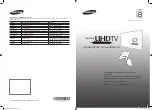
19
few things for this type of installation:
A suitable mounting depth
—
Most speakers need 3-6 inches of space behind the wall or
ceiling. If you go this route, make sure there aren't drain lines or wires blocking the way.
A sturdy mounting surface
—
For this, properly installed drywall will usually provide a stable
area.
Wire access
—
Some high quality wire can be as thick as your finger. How do you want it run?
Is the wire you will be using code compliant? (See "Running Wires" section for more
information.)
Soundproofing
—
Things may sound great in one room, but can be irritating to those in the
next room. Proper treatment will cut down unwanted noise, as well as help your sound quality.
A working knowledge of your house's construction
—
Before you begin installation, know what is
hidden before you cut or drill! This will help avoid any costly uses of the word "oops."
Needed ToolsSome tools used in the installation profession can cost hundreds of dollars. However,
these tools can save hours of work on a project and allow a skilled installer to learn about a house's
construction without cutting into the wall. They also eliminate much of the risk involved in working near
electrical and plumbing systems. Here is a list of tools needed for speaker mounting:
? Stud finder
? Tape measure
? Level
? Drywall Saw
? Pencil
? Power drill
? Flashlight
? Speaker template
—
usually comes with recessed speakers
? Wall probe
—
piano wire, etc
? Wire running tools
—
fish/carpet tape, flex rods, electrical
tape
Running Wires You'll have to get a wire from your speaker to your equipment. There are a few rules
you'll need to be aware of when it comes to running wires: The National Electrical Code (NEC) is a set
of rules that govern how wires and varying types of power are to be run in a building. These rules cover
both high voltage (outlets, light switches) and low voltage (phone lines, speaker wires, cable lines). Any
work you do MUST be in accordance with the NEC, as well as local ordnances for your city, county and
state. It's good to have a clear understanding of these rules before you begin. Speaker wire can be
susceptible to interference from external sources, such as electrical lines. The NEC dictates minimum
safe clearances for wires, but it is best to keep as much distance between your speaker wires and any
potential sources of interference
—
you don't want to get all the way through your install only to
discover your speakers "buzz" or "hum" constantly. The wire you use is as important as the speaker
and amplifier themselves. The type of copper and how thick it is, the jacket protecting the copper, the
distance it's run
—
all of these impact how your system will perform. Make sure you're choosing wire
that is the proper material and has a thick enough gauge for the location and distance it will be
run.There are also different wire ratings that dictate what kind of wires are run within different areas of a
house. For example, certain wires are "in-wall" rated, while others are rated for what can be run outside,
underground, in HVAC ducts, etc. Since this is spelled out by the NEC and in any local restrictions
codes, it is strongly recommended that you make use of a professional installer if you're unsure of local
ordinances.
Summary of Contents for HLC15E-D
Page 29: ...29 ...
Page 51: ...40 11 WIRING CONNECTION DIAGRAM ...
Page 57: ...46 Sincere Forever ...
















































